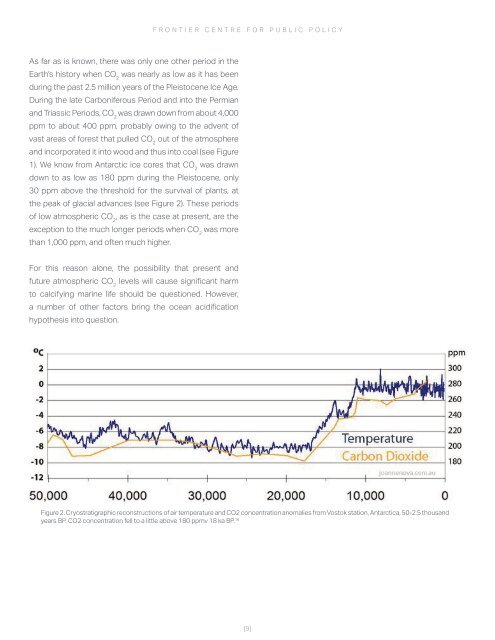OCEAN “ACIDIFICATION” ALARMISM IN PERSPECTIVE
rUUhYH
rUUhYH
Create successful ePaper yourself
Turn your PDF publications into a flip-book with our unique Google optimized e-Paper software.
FRONTIER CENTRE FOR PUBLIC POLICY<br />
As far as is known, there was only one other period in the<br />
Earth’s history when CO 2<br />
was nearly as low as it has been<br />
during the past 2.5 million years of the Pleistocene Ice Age.<br />
During the late Carboniferous Period and into the Permian<br />
and Triassic Periods, CO 2<br />
was drawn down from about 4,000<br />
ppm to about 400 ppm, probably owing to the advent of<br />
vast areas of forest that pulled CO 2<br />
out of the atmosphere<br />
and incorporated it into wood and thus into coal (see Figure<br />
1). We know from Antarctic ice cores that CO 2<br />
was drawn<br />
down to as low as 180 ppm during the Pleistocene, only<br />
30 ppm above the threshold for the survival of plants, at<br />
the peak of glacial advances (see Figure 2). These periods<br />
of low atmospheric CO 2<br />
, as is the case at present, are the<br />
exception to the much longer periods when CO 2<br />
was more<br />
than 1,000 ppm, and often much higher.<br />
For this reason alone, the possibility that present and<br />
future atmospheric CO 2<br />
levels will cause significant harm<br />
to calcifying marine life should be questioned. However,<br />
a number of other factors bring the ocean acidification<br />
hypothesis into question.<br />
Figure 2. Cryostratigraphic reconstructions of air temperature and CO2 concentration anomalies from Vostok station, Antarctica, 50-2.5 thousand<br />
years BP. CO2 concentration fell to a little above 180 ppmv 18 ka BP. 16<br />
[9]


